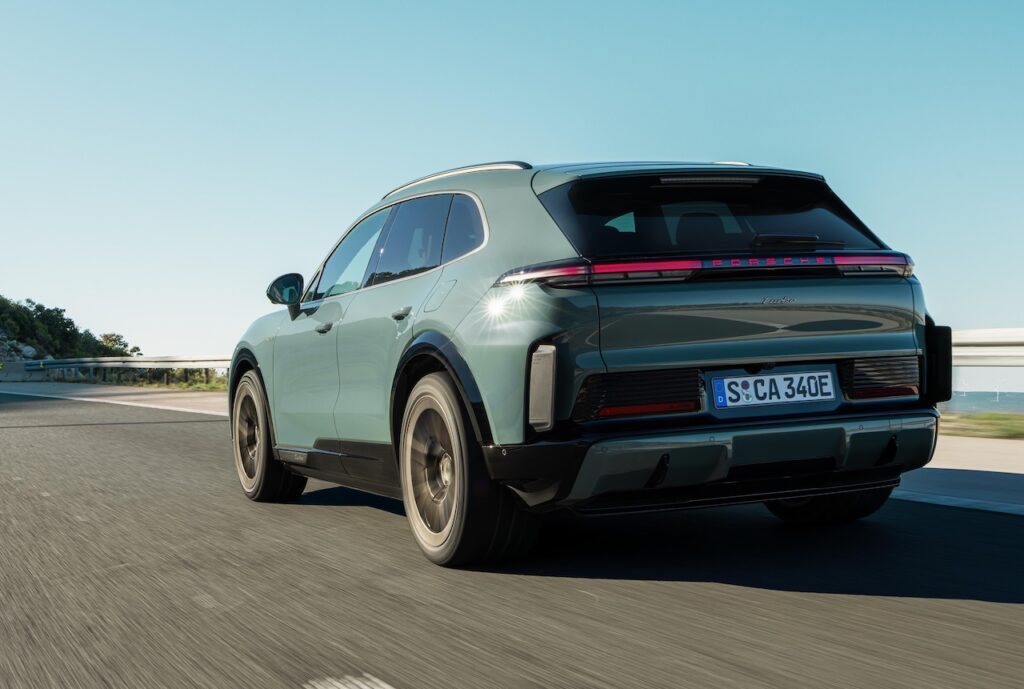2026 Porsche Cayenne EV revealed, Aussie price and specs announced: 850kW luxury performance SUV is a hypercar humbler with 3500kg braked towing!
The all-new 2026 Porsche Cayenne Electric has been unwrapped and its Australian debut confirmed for around July next year with pricing from $167,800 plus on-roads.
Built to deliver class-leading acceleration, charging speeds and driving dynamics, the headline $259,900 Porsche Cayenne Turbo arrives with an astonishing 850kW of power and as much as 1500Nm.
It will challenge many hypercars for acceleration away from the lights with its 0-100km/h sprint of just 2.5 seconds.
READ MORE: 2026 Porsche Macan GTS arrives to smash the Tesla Model Y Performance: German car-maker claims it makes the sportiest electric SUV
READ MORE: 2025 Porsche Macan Turbo Review: A drive into the country to decide if an electric Porsche still drives like a Porsche
READ MORE: Porsche EV plan hits the skids! Billions lost, ICE replacements for 718 Boxster and Cayman confirmed, new-gen Taycan and K1 super-SUV delayed
While the most affordable Cayenne EV commands a premium over the most affordable Cayenne E-Hybrid ($154,600), the Turbo is actually cheaper than the $288,400 charged for the slower plug-in Turbo E-Hybrid.

Behind the wheel, Porsche thinks many buyers will prefer the new fourth-gen battery-powered SUV thanks to its pioneering tech, fast-charging, admirable efficiency and jaw-dropping levels of performance.
Sharing the same PPE platform as the Macan Electric, which was launched almost a year ago, the two new battery-powered Cayennes come with dual-motors for standard all-wheel drive.
The entry version produces up to 325kW and a muscular 825Nm of torque in Launch Control for a brisk 0-100km/h dash of just 4.8 seconds.
Some Australian buyers are expected to overlook the first rung of the electric SUV ladder and plump for the full-fat Cayenne Turbo. Its massive outputs are aided by an all-new rear motor that features direct oil cooling for maximum efficiency and power.
As well as being blisteringly quick from 0-100km/h (2.5 seconds), more remarkable is the 7.4 seconds the 2645kg Cayenne Turbo takes to reach 200km/h froma standng start.
That’s a whole second faster than the latest 911 Turbo S, matching what some million dollar hypercars claim. However, the Porsche’s top speed is limited to a far lower 260km/h than a Bugatti tops out at.

Cross country, Porsche says the Cayenne EV’s 800-volt electrics and new 108kWh (usable) battery means you won’t have to spend much time charging, with a 10-80 per cent top up at a rate of 400kW taking just 16 minutes.
Even if you can’t find one of the new breed ultra-fast DC chargers, a 400-volt top up is still at an impressive rate of 200kW.
Many owners will prefer home charging and, in a world first, Porsche will offer 11kW AC inductive charging pads that are 90 per cent efficient compared to plugging in.
But they could cost more than $10,000 when offered as an option.
With a full charge, the Cayenne Electric can travel up to 642km, while the Turbo covers a still-impressive 623km.

Cutting drag to just 0.25Cd for both models is active aero. On the Cayenne Turbo that consists of a pop-up tailgate-spoiler, front splitter that lowers at speeds and a pair of weird air blades that extend from the rear bumper.
Under brakes, Porsche says up to 98 per cent of real-world braking is via regen, with the flagship Turbo able to claw back an incredible 600kW of energy.
When regen isn’t enough, there are powerful carbon-ceramic stoppers built for track work.
Expect the inbound battery-electric Cayenne Coupe, which might carry the Turbo GT nameplate, to set a new Nurburgring lap record for an SUV., regardless of what it’s powered by.

Helping keep it tied down in corners is the standard adaptive air suspension that can be upgraded with the Porsche Active Suspension. This system uses hydraulically interlinked dampers to dial out body roll and the pitch and dive associated with accelerating and braking.
Boosting traction further the Turbo gets a limited-slip rear differential that introduces torque vectoring.
Finally, rear-wheel steering is also available which maximises high-speed stability and low speed agility, which means the electric Cayenne should be far nimbler than the current car, despite measuring in at around the same footprint (4985mm).
Inside Porsche has nailed the brief for the tech obsessed. There’s a 14.25-inch instrument cluster that’s combined with an enormous 87-inch augmented reality-aided head-up display. There’s also the brand’s latest curved Flow infotainment (12.25-inch) that can be specified with a third 14.9-inch passenger touchscreen.
Enhancing usability are physical buttons for the climate control and audio volume, while a new operating system and AI-powered voice control should boost the system’s intuitiveness.
The new Porsche SUV is capable of towing up to 3500kg, but in order to do so buyers must option the Off-Road pack.
This pack introduces underbody armour and a reprofiled front and rear bumper to capitalise on its decent maximum 245mm ground clearance.
Without the pack, towing is limited to 3000kg, which is still at thew top-end for an EV.




